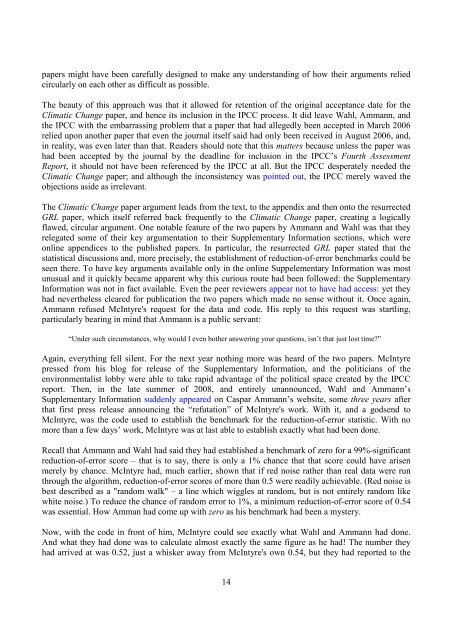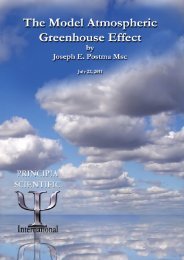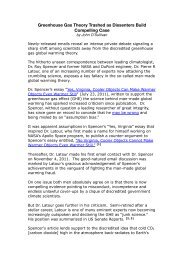Hockey Stick? What Hockey Stick? - WEBCommentary
Hockey Stick? What Hockey Stick? - WEBCommentary
Hockey Stick? What Hockey Stick? - WEBCommentary
You also want an ePaper? Increase the reach of your titles
YUMPU automatically turns print PDFs into web optimized ePapers that Google loves.
papers might have been carefully designed to make any understanding of how their arguments relied<br />
circularly on each other as difficult as possible.<br />
The beauty of this approach was that it allowed for retention of the original acceptance date for the<br />
Climatic Change paper, and hence its inclusion in the IPCC process. It did leave Wahl, Ammann, and<br />
the IPCC with the embarrassing problem that a paper that had allegedly been accepted in March 2006<br />
relied upon another paper that even the journal itself said had only been received in August 2006, and,<br />
in reality, was even later than that. Readers should note that this matters because unless the paper was<br />
had been accepted by the journal by the deadline for inclusion in the IPCC’s Fourth Assessment<br />
Report, it should not have been referenced by the IPCC at all. But the IPCC desperately needed the<br />
Climatic Change paper; and although the inconsistency was pointed out, the IPCC merely waved the<br />
objections aside as irrelevant.<br />
The Climatic Change paper argument leads from the text, to the appendix and then onto the resurrected<br />
GRL paper, which itself referred back frequently to the Climatic Change paper, creating a logically<br />
flawed, circular argument. One notable feature of the two papers by Ammann and Wahl was that they<br />
relegated some of their key argumentation to their Supplementary Information sections, which were<br />
online appendices to the published papers. In particular, the resurrected GRL paper stated that the<br />
statistical discussions and, more precisely, the establishment of reduction-of-error benchmarks could be<br />
seen there. To have key arguments available only in the online Suppelementary Information was most<br />
unusual and it quickly became apparent why this curious route had been followed: the Supplementary<br />
Information was not in fact available. Even the peer reviewers appear not to have had access: yet they<br />
had nevertheless cleared for publication the two papers which made no sense without it. Once again,<br />
Ammann refused McIntyre's request for the data and code. His reply to this request was startling,<br />
particularly bearing in mind that Ammann is a public servant:<br />
“Under such circumstances, why would I even bother answering your questions, isn’t that just lost time?”<br />
Again, everything fell silent. For the next year nothing more was heard of the two papers. McIntyre<br />
pressed from his blog for release of the Supplementary Information, and the politicians of the<br />
environmentalist lobby were able to take rapid advantage of the political space created by the IPCC<br />
report. Then, in the late summer of 2008, and entirely unannounced, Wahl and Ammann’s<br />
Supplementary Information suddenly appeared on Caspar Ammann’s website, some three years after<br />
that first press release announcing the “refutation” of McIntyre's work. With it, and a godsend to<br />
McIntyre, was the code used to establish the benchmark for the reduction-of-error statistic. With no<br />
more than a few days’ work, McIntyre was at last able to establish exactly what had been done.<br />
Recall that Ammann and Wahl had said they had established a benchmark of zero for a 99%-significant<br />
reduction-of-error score – that is to say, there is only a 1% chance that that score could have arisen<br />
merely by chance. McIntyre had, much earlier, shown that if red noise rather than real data were run<br />
through the algorithm, reduction-of-error scores of more than 0.5 were readily achievable. (Red noise is<br />
best described as a "random walk" – a line which wiggles at random, but is not entirely random like<br />
white noise.) To reduce the chance of random error to 1%, a minimum reduction-of-error score of 0.54<br />
was essential. How Amman had come up with zero as his benchmark had been a mystery.<br />
Now, with the code in front of him, McIntyre could see exactly what Wahl and Ammann had done.<br />
And what they had done was to calculate almost exactly the same figure as he had! The number they<br />
had arrived at was 0.52, just a whisker away from McIntyre's own 0.54, but they had reported to the<br />
14





